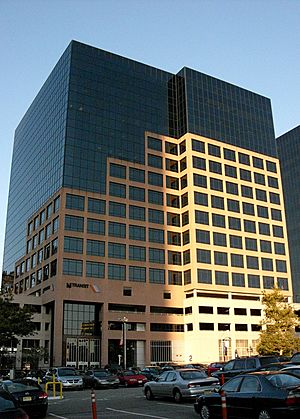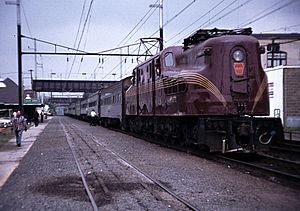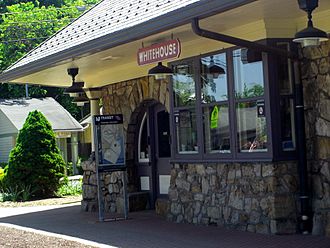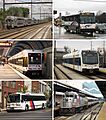NJ Transit facts for kids
Quick facts for kids NJ Transit |
|
|---|---|
NJT services samples rail bus and light rail.jpg |
|
| Info | |
| Locale | New Jersey (statewide), New York, Rockland and Orange counties in New York State, and Philadelphia and Northampton counties in Pennsylvania, New Jersey, New York are included |
| Transit type |
|
| Number of lines |
|
| Number of stations |
|
| Chief executive | Kris Kolluri |
| Headquarters | 2 Gateway Center, Newark, New Jersey |
| Website | njtransit.com |
| Operation | |
| Began operation | July 17, 1979 |
| Operator(s) |
|
| Number of vehicles |
|
| Technical | |
| System length |
|
NJ Transit (short for New Jersey Transit Corporation) is a public transportation system. It is owned by the state of New Jersey. NJ Transit helps people travel across New Jersey. It also serves parts of New York and Pennsylvania.
NJ Transit runs buses, light rail trains, and commuter trains. These services connect people to major cities and job centers. This includes places within New Jersey, and also New York City and Philadelphia. NJ Transit is the largest statewide public transit system in the U.S. It is also the third-largest provider of bus, rail, and light rail services by how many people ride it.
Contents
How NJ Transit Started
NJ Transit began on July 17, 1979. It was created by the New Jersey government. The goal was to fix transportation problems in the state. NJ Transit was told to "acquire, operate, and contract for transportation service."
At first, NJ Transit took over many private bus companies. One of the biggest was run by a power company. Over time, NJ Transit took over most bus services in New Jersey. In northern New Jersey, bus routes spread out like a web. In southern New Jersey, routes often start from a main point. These points include Trenton, Camden, and Atlantic City.
In 1983, NJ Transit started running all commuter train services in New Jersey. Before this, another company called Conrail ran them. Conrail had taken over many older train lines. NJ Transit now runs almost every passenger and commuter train line in the state. Since it started, the number of people riding NJ Transit trains has grown four times!
Growing the Train System
In the 1990s, the train system got bigger. New "Midtown Direct" service started to New York City. New trains were also added. On October 21, 2001, a new train station opened at Newark Liberty International Airport.
On December 15, 2003, Secaucus Junction station opened. This station connected NJ Transit's two main train networks in northern New Jersey. Passengers could now easily switch trains to get to New York Penn Station. This saved about 15 minutes of travel time. On October 31, 2005, NJ Transit took over the "Clocker" train service from Amtrak.
From 2009 to 2011, NJ Transit ran the Atlantic City Express Service (ACES). This was a special train from New York Penn Station to Atlantic City. It ran on weekends and during certain seasons.
In October 2012, Hurricane Sandy caused big problems. The main control center for NJ Transit trains was flooded. Many train engines and cars were damaged by the water.
On May 16, 2025, train service was stopped. This was because of a pay dispute with train engineers. An agreement was reached on May 18, 2025. Full train service started again after safety checks.
How NJ Transit is Managed
The Governor of New Jersey chooses a group of thirteen people to lead NJ Transit. Eleven of these people can vote on decisions. Two members do not vote. The Governor can say no to decisions made by this group.
How NJ Transit Works Today

NJ Transit has three main types of service: bus, light rail, and commuter rail. These are run by different parts of the company.
Bus Services
NJ Transit Bus Operations runs 253 bus routes. It uses 2,356 buses. Some smaller companies also run routes for NJ Transit. They use 696 additional buses.
Light Rail Services
NJ Transit operates three light rail systems:
- Hudson–Bergen Light Rail: This system has three lines and 24 stations. It runs for 20.6 miles (33.2 km) along the Hudson Waterfront. It connects towns in Hudson County.
- Newark Light Rail: This system has two lines and 17 stations. It runs for 5.3 miles (8.5 km). It connects to major transportation spots in Newark.
- River Line: This line has 21 stations and runs for 34 miles (55 km). It goes along the Delaware River from Trenton to Camden. This line uses special diesel trains.
Commuter Rail Services
NJ Transit runs thirteen commuter train lines. Two of these are operated with Metro-North Railroad. Some popular lines include:
- Atlantic City Line
- Northeast Corridor Line
- North Jersey Coast Line
- Raritan Valley Line
NJ Transit Police
The New Jersey Transit Police Department (NJTPD) is the police force for NJ Transit. Their job is to keep people safe. They also protect bus terminals, train stations, and other NJ Transit property. The department has about 250 police officers. They have the same powers as other police officers in New Jersey.
Current Projects
NJ Transit is always working on new projects to improve service.
Gateway Program
This big project will make the Northeast Corridor train line better. It will add new tracks and tunnels under the Hudson River. This will allow more trains to run. The project will create four main tracks between Newark, NJ, and New York Penn Station. This includes a new two-track tunnel under the Hudson River.
Portal Bridge Replacement
This project is part of the Gateway Program. It will replace a very old bridge called the Portal Bridge. This bridge swings open for boats, which causes train delays. The new bridge will be fixed in place. This will make train travel more reliable and faster.
Hudson Tunnel Project
This project will build a new train tunnel under the Hudson River. This new tunnel will go to New York Penn Station. It will also fix the two old tunnels, called the North River Tunnels. These old tunnels were badly damaged by saltwater during Hurricane Sandy. Building a new tunnel means trains can keep running while the old ones are fixed.
Hudson–Bergen Light Rail Extensions
Northern Branch Extension
This project will make the Hudson–Bergen Light Rail longer. It will go from North Bergen to Englewood. This extension will help more people travel easily. It will also reduce traffic on roads. As of December 2022, the project is still being designed.
Route 440 Extension
This project will extend the Hudson–Bergen Light Rail in Jersey City. It will add 0.7 miles (1.1 km) of new track. This will lead to a new station on the west side of Route 440. This new station will help a big project to improve the Bayfront area.
Lackawanna Cut-Off Restoration
This project aims to bring back train service on an old railway line. This line, called the Lackawanna Cut-Off, was built over 100 years ago. It was designed for a direct route with few curves. NJ Transit bought the land for this line in 2001. The first part of the project, from Port Morris to Andover, started in 2011. As of 2023, this part of the project is expected to be finished by 2027.
Glassboro–Camden Line
The Glassboro–Camden Line is a planned 18-mile (29 km) light rail system. It will run in the southwestern part of New Jersey. It will connect with the River Line in Camden. This project will help people travel between towns in Gloucester and Camden counties. The project is currently being designed and engineered. It is expected to be ready by 2028.
Bus Rapid Transit
NJ Transit is working on "Next Generation Bus" projects. These are like special bus systems. They include buses that make limited stops and special bus lanes. NJ Transit is also adding real-time tracking to all its buses. This will let people know exactly when their bus will arrive.
Recovery and Resilience Projects
After Hurricane Sandy, NJ Transit started many projects to fix and protect its system. Repairs to Hoboken Terminal were finished by 2020. Many power lines and flood protection systems have been improved. An old bridge, the 110-year-old Raritan Bay Drawbridge, is being replaced with a new, higher bridge.
Proposed Projects
NJ Transit is also looking into other possible projects for the future.
West Trenton Line
This is a proposed train service. It would connect West Trenton Station to Newark Penn Station. This service ran before 1983. As of 2004, the estimated cost was $197 million, but no money has been found for it yet.
West Shore Commuter Rail Line
This project would bring back passenger train service on the West Shore Railroad. This line would run from Hoboken, NJ, to West Nyack, NY. This route could help many commuters. However, there are challenges. Another company, CSX, uses these tracks a lot for freight. Also, there is no easy way to connect this line to New York Penn Station. Because of these issues, this project is on hold.
Passaic–Bergen–Hudson Transit Project
This project would bring back passenger service on another old railway line. It would run in Passaic, Bergen, and Hudson counties. It would also connect to the Hudson–Bergen Light Rail. This project is still in its early study phase.
Monmouth-Ocean-Middlesex (MOM) Line
The MOM line is a proposed commuter train route. It would run in southern and central New Jersey. It would connect to New Brunswick, Newark, and New York Penn Station. This line would use existing freight tracks. There have been different ideas for the route over the years. As of August 2010, NJ Transit received money to study the possibilities. However, there has been no further progress since then.
Lehigh Valley Extension
This project would extend the Raritan Valley Line into eastern Pennsylvania. It could include stops in Allentown, Bethlehem, and Easton. Passenger service to these cities ended in 1967. A study was done in 2008 to explore this idea.
Past Projects That Were Canceled
Access to the Region's Core (ARC)
NJ Transit had planned to build a new two-track tunnel under the Hudson River. This project was called "Access to the Region's Core." It would have allowed trains from many lines to go directly to New York Penn Station. The project started in June 2009. However, it was stopped on October 7, 2010. This was because of concerns about high costs. The Governor of New Jersey made the final decision to cancel it on October 27, 2010.
Newark–Elizabeth Rail Link
This project planned to connect Downtown Newark and Elizabeth by train. It would have gone through Newark Liberty International Airport. However, NJ Transit is no longer working on this project. The airport already has a monorail that connects to other train lines going to Newark and Elizabeth.
Incidents and Events
- In December 1985, a train crashed into a bumper at Hoboken Terminal. 54 people were hurt.
- On February 9, 1996, two trains crashed near Secaucus. Three people died. The crash happened because one train went past a red signal.
- On July 14, 2003, a train went off the tracks near the Portal Bridge. This caused delays for many hours.
- On September 29, 2016, a train crashed into the passenger area at Hoboken Terminal. One person died and about 100 were injured.
- On August 19, 2016, two NJ Transit buses crashed in Newark. Two people died and 18 were injured.
- On December 14, 2023, a Texas Longhorn bull walked onto the train tracks at Newark Penn Station. Train service was paused. Police safely caught the bull, who was named Ricardo. NJ Transit later sold a Ricardo the Bull toy to remember the event. Part of the money went to an animal sanctuary.
- On October 14, 2024, a light rail train hit a tree on the River Line. One person died and 23 were injured.
Images for kids
See also
 In Spanish: New Jersey Transit para niños
In Spanish: New Jersey Transit para niños





